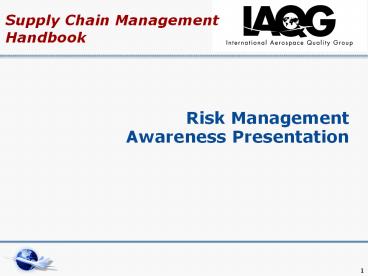Risk Management Awareness Presentation - PowerPoint PPT Presentation
Title:
Risk Management Awareness Presentation
Description:
Supply Chain Management Handbook Risk Management Awareness Presentation * Risk Management Concepts & Philosophies What is risk? (ISO 31000) Where do risks appear in ... – PowerPoint PPT presentation
Number of Views:5372
Avg rating:3.0/5.0
Title: Risk Management Awareness Presentation
1
Risk ManagementAwareness Presentation
Supply Chain Management Handbook
2
Contents
- Risk Management Concepts Philosophies
- What is risk? (ISO 31000)
- Where do risks appear in the business phases?
- What is risk management?
- Why do you want risk management?
- What does a risk management program do?
3
Contents
- Processes
- What are the Elements of a risk management
program? - How do the elements relate to a Management System
Risk Management Tools (9134)? - Examples
- Examples of types of risks
- Example of specific risks in that risk type
- Organizational Risk Maturity Model
- Risk managemnt and the 9100 Quality standard
4
What is Risk?
Risk Management Concepts Philosophies
- ISO 31000
- An undesirable situation or circumstance that has
both a likelihood of occurring and a potentially
negative consequence
5
Where are we confronted with risks during the
business phases?
Risk Management Concepts Philosophies
6
What is risk management?
Risk Management Concepts Philosophies
- An iterative process to identify, assess, reduce,
accept, and control risks in a systematic,
proactive, comprehensive and cost effective
manner, taking into account the business, costs,
technical, quality and schedule programmatic
constraints.
7
Why do you want risk management?
Risk Management Concepts Philosophies
- To reduce the chances of something harmful
happening to the business. This involves a focus
on the risks to meeting customer requirements,
and preventing product non conformance escapes.
The absence of a Risk Management program can
result in known, unknown, and unknowable
/unforeseen problems for the Customer and
Stakeholders concerning the cost, schedule, and
technical performance of programs and concerning
the quality and on-delivery performance of
products and services.
8
What does a Risk Management Program do?
Risk Management Concepts Philosophies
- Describes the organization's attitude and
approach towards risks, how it conducts risk
management, the risks it is prepared to accept
and how it plans on dealing with those it chooses
not to accept and defines the main requirements
for a risk management plan.
9
What does a Risk Management Program do?
Risk Management Concepts Philosophies
- A Risk Management Program
- Helps Organization (company structure)
- to identify risks
- to reduce occurances and impacts of risks
- to understand significance/severity of risks
- to promote organizational behaviors forcused on
risk management - to increase effectiveness of product and service
delivery to customer
10
What does a Risk Management Program do?
Risk Management Concepts Philosophies
- A Risk Management Program
- Creates a process for who, what, when, where, how
and how much. - Helps us to maintain information on historic
issues. - Helps capitalize on historic issues to prevent
future issues. - Helps organization bring out hidden risk
knowledge, so it can be managed.
11
What are the elements of a Risk Management
Program?
Processes
12
Risk Management Tools (examples 9134)
Processes
13
Risk Management Tools (examples 9134)
Processes
14
Risk Management Tools (examples 9134)
Processes
15
Examples of types of risks
Risk Management Concepts Philosophies
- Financial
- Strategic
- Compliance / Effectiveness
- Operational / Planning including physical
environmental - Human Factors
- Political (import export controls)
- Environment Health Safety
- Ethical, legal, image
16
Example of specific risks in that risk type
Processes
Adapted from James Reason, Managing the Risks
of Organizational Accidents, 1997, p. 12
17
Organizational Risk Maturity Model
18
Organizational Risk Maturity Model
19
Organizational Risk Maturity Model
20
Risk Management and the 9100 Quality Standard
- 0.1 General
- 3.1 Definition of Risk
- 3.2 Special Requirements
- 3.3 Critical Items
- 3.4 (7.2.1, 7.2.2, 7.3.3) Key characteristics
- 7.1.1 Risk Management while doing Project
Management - 7.1.2 Risk Management
- 7.2.2 Product Risks
- 7.4.1 Supply Chain Risk
- 8.5.3 Preventive actions
- Note When viewing the wording of the 9100 2009
standard, be aware of wording such as 'as
appropriate', 'complexity' and other wording that
provides the organization for options. Applying
the concepts of Risk may have an influence as to
the options that an organization implements.































